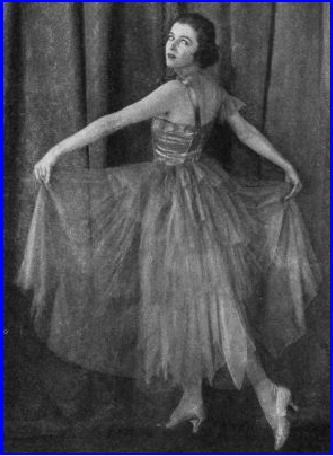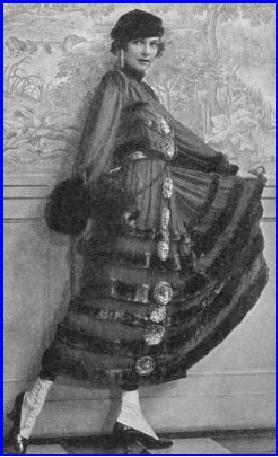 |
THE RENAISSANCE |
| << DEVELOPMENT OF GOTHIC COSTUME |
| EIGHTEENTH CENTURY >> |

"Crystallised
glorias" (hymns to the
Virgin) is as concise a defining of the
nature
and
spirit of this highest type
of mediŠval art--perfected in France--as
we can
find.
Here we have deified woman
inspiring an art miraculously
decorative.
Chartres
Cathedral and Rheims (before
the German invasion in 1914)
with Mont
Saint
Michel, are distinguished
examples.
If
the readers would put to
the test our claim that
woman as decoration is a
beguiling
theme worthy of days passed in
the broad highways of art, and
many an
hour
in cross-roads and unbeaten paths, we
would recommend to them
the
fascinations
of a marvellous story-teller, one who,
knowing all there is to know
of
his
subject, has had the genius
to weave the innumerable and
perplexing threads
into
a tapestry of words, where
the main ideas take their
places in the
foreground,
standing
out clearly defined against
the deftly woven,
intelligible but
unobtruding
background.
The author is Henry Adams,
the book, The
Cathedrals of Mont
St.
Michel
and Chartres. He tells
you in striking language,
how woman was
translated
into
pure decoration in the
Middle Ages, woman as the
Virgin Mother of God,
the
manifestation
of Deity which took
precedence over all others
during the twelfth,
thirteenth
and fourteenth centuries; and if
you will follow him to the
Chartres
Cathedral
(particularly if you have
been there already), and will stand
facing the
great
East Window, where in stained
glass of the ancient
jewelled sort, woman,
as
Mother
of God, is enthroned above all, he will
tell you how, out of
the chaos of
warring
religious orders, the priestly
schools of Abelard, St.
Francis of Assisi and
others,
there emerged the form of
the Virgin.
To
woman, as mother of God and
man, the instrument of
reproduction, of tender
care,
of motherhood, the disputatious,
groping mind of man agreed
to bow, silenced
and
awed by the mystery of her
calling.
In
view of the recent enrolling
of womanhood in the stupendous
business of the war
now
waging in Europe, and the
demands upon her to help in
arming her men or
nursing
back to life the shattered remains of
fair youth, which so bravely
went
forth,
the thought comes that
woman will play a large part
in the art to arise
from
the
ashes of to-day. Woman as
woman ready to supplement
man, pouring into
life's
caldron
the best of herself,
unstinted, unmeasured; woman
capable of serving
beyond
her strength, rising to her
greatest height, bending,
but not breaking to
the
end,
if only assured she is
needed.
CHAPTER
XVII
THE
RENAISSANCE
Sixteenth
and Seventeenth Centuries
HE
marked
departure is necks cut square, if low,
and elaborate jewelled
chains
draped from shoulders,
outlining neck of gown and
describing a
festoon
on front of waist, which is soon to
become independent of skirt
to
develop
on its own account.
As
in the fifteenth century,
when necks were cut low
off the shoulders, they
were
on
occasions filled in with
tuckers.
The
skirt now registers a new
characteristic; it parts at the waist
line over a
petticoat,
and the opening is decorated by the
ornamental, heavy chain
which hangs
from
girdle to hem of
gown.
One
sees the hair still
worn coiled low in the
neck, concealing the ears
and held in a
snood
or in Italy cut "Florentine"
fashion with fringe on
brow.
Observe
how the wealth of the
Roman Empire, through its
new trade channels
opening
up with the East (the
result of the crusades) led
to the importation of
rich
and
many-coloured Oriental stuffs;
the same wealth ultimately
established looms in
Italy
for making silks and
velvets, to decorate man and
his home. There was
no
longer
simplicity in line and colour scheme;
gorgeous apparel fills the frames of
the
Renaissance
and makes amusing reading
for those who consult old
documents. The
clothes
of man, like his over-ornate
furniture, show a debauched
and vulgar taste.
Instead
of the lines which follow
one another, solid colours, and
trimmings kept to
hem
of neck and sleeve and skirt, great designs, in satins
and velvet brocades,
distort
the lines and proportions of
man and woman.
The
good Gothic lines lived on in
the costumes of priests and nuns.
Jewelry
ceased to be decoration with
meaning; lace and fringe, tassels
and
embroidery,
with colour combinations to
rival the African parrots,
disfigured man
and
woman alike.
During
November of 1916, New York
was so fortunate as to see, at
the American
Art
Galleries, the great collection of
late Gothic and early
Renaissance furniture
and
other art treasures, brought
together in the restored Davanzati
Palace of
Florence,
Italy. The collection was
sold at auction, and is now scattered. Of
course
those
who saw it in its natural
setting in Florence, were
most fortunate of all.
But
with
some knowledge and
imagination, at the sight of those
wonderful things,--
hand-made
all of them,--the most casual
among those who crowded the
galleries
for
days, must have gleaned a
vivid impression of how
woman of the Early
Renaissance
lived,--in her kitchen,
dining-room, bedroom and
reception-rooms.
They
displayed her cooking
utensils, her chairs and
tables, her silver, glass
and
earthenware,
her bed, linen, satin
damask, lace and drawn work; the
cushions she
rested
against; portraits in their gorgeous
Florentine frames, showing us
how those
early
Italians dressed; the
colored terra-cottas, unspeakably
beautiful presentments
of
the Virgin and Child,
moulded and painted by great artists
under that same
exaltation
of Faith which brought into
being the sister arts of the
time, imbuing
them
with something truly divine.
There is no disputing that
quality which
radiates
from
the face of both the Mother
and the Child. One all
but kneels before it.
Their
expression
is not of this world.
PLATE
XXIII
Mrs.
Vernon Castle who set
to-day's fashion
in
outline of costume and short
hair for the
young
woman of America. For this
reason
and
because Mrs. Castle has form
to a
superlative
degree (correct carriage of
the

body)
and the clothes sense
(knowledge of
what
she can wear and how to wear
it) we
have
selected her to illustrate
several types of
costumes,
characteristic of 1916 and 1917.
Another
reason for asking Mrs.
Castle to
illustrate
our text is, that
what Mrs. Castle's
professional
dancing has done to develop
and
perfect
her natural instinct for
line, the
normal
exercise of going about one's
tasks
and
diversions can do for any
young woman,
provided
she keep in mind correct
carriage of
body
when in action or repose.
Here we see
Mrs.
Castle in ball costume.
Mrs.
Vernon Castle in Ball
Costume
That
is woman as the Mother of
God in art Woman as the
mother of man, who
looked
on these inspired works of
art, lived for the
most part in small houses
built
of
wood with thatched roofs,
unpaved streets, dirty interiors,
which were cleaned
but
once a week--on Saturdays! The
men of the aristocracy
hunted and engaged in
commerce,
and the general rank and
file gave themselves over to
the gaining of
money
to increase their power. It sounds
not unlike New York
to-day.
Gradually
the cities grew large and
rich. People changed from
simple sober living
to
elaborate and less temperate ways, and
the great families, with
their
proportionately
increased wealth gained through
trade, built beautiful
palaces and
built
them well. The gorgeous
colouring of the frescoed walls
shows Byzantine
influence.
In The
Art of Interior Decoration
we
have described at length the
house
furnishing
of that time. Against this
background moved woman, man's
mate; note
her
colour scheme and then her
r˘le. (We quote from Jahn
Rusconi in Les
Arts,
Paris,
August, 1911.)
"Donna
Francesca dei Albizzi's cloak of
black cloth ornamented on a
yellow
background
with birds, parrots,
butterflies, pink and red roses, and a
few other red
and
green figures; dragons, letters and trees
in yellow and black, and again
other
figures
made of white cloth with
red and black
stripes."
Extravagance
ran high not only in
dress, but in everything,
laws were made to
regulate
the amount spent on all
forms of entertainment, even on
funerals, and the
cook
who was to prepare a wedding feast
had to submit his menu
for approval to
the
city authorities. More than
this, only two hundred
guests could be asked to
a
wedding,
and the number of presents
which the bride was allowed
to receive was
limited
by law. But wealth and
fashion ran away with
laws; the same old
story.
As
the tide of the Renaissance
rose and swept over Europe
(the awakening began
in
Italy),
the woman of the gorgeous
cloak and her contemporaries,
according to the
vivid
description of the last
quoted author, were "subject
to their husbands' tyranny,
not
even knowing how to read in
many cases, occupied with
their household
duties,
in
which they were assisted by
rough and uncouth slaves, with no
other mission in
life
than to give birth to a
numerous posterity... This
life ruined them, and
their
beauty
quickly faded away; no wonder,
then, that they summoned
art to the aid of
nature.
The custom was so common and
the art so perfect that
even a painter like
Taddeo
Gaddi acknowledged that the
Florentine women were the
best painters in
the
world!... Considering the
mental status of the women, it is
easy to imagine to
what
excesses they were given in
the matter of dress." The above
assertions relate
to
the average woman, not
the great exceptions.
The
marriage coffers of woman of
the Renaissance in themselves
give an idea of
her
luxurious tastes. They were
about six feet long,
three feet high, and
two and a
half
feet deep. Some had domed
covers opening on hinges--the
whole was carved,
gilded
and painted, the background of
reds and blues throwing the
gold into relief.
Scenes
taken from mythology were
done in what was known as
"pastille,"
composition
work raised and painted on a
gold background. On one
fifteenth
century
marriage coffer, Bacchus and
Ariadne were shown in their
triumphal car
drawn
by winged griffins, a young
Bacchante driving them on.
Another coffer
decorated
in the same manner had as
decoration "The Rape of
Proserpine."
Women
rocked their infants in
sumptuous carved and emblazoned
walnut cradles,
and
crimson satin damask covered
their beds and cushions.
This blaze of gold
and
silver,
crimson and blue we find as
the wake of Byzantine trade,
via
Constantinople,
Venice, Rome, Florence on to France,
Spain, Germany,
Holland,
Flanders
and England. Carved wood,
crimson, green and blue velvets,
satin
damask,
tapestries, gold and silver fringe and
lace. Against all this
moved woman,
costumed
sumptuously.
Gradually
the line of woman's (and
man's) neck is lost in a
ruff, her sweeping
locks,
instead
of parted on her brow, entwined
with pearls or other gems to
frame her face
and
make long lines down the
length of her robe, are
huddled under grotesque
head
-dresses,
monstrous creations, rising and spreading
until they become
caricatures,
defying
art.
In
some sixteenth century
Italian portraits we see the
ruff flaring from a neck
cut
out
square and low in front,
then rising behind to form a
head covering.
The
last half of the sixteenth
century is marked by gowns
cut high in the neck
with
a
close collar, and the appearance of a
small ruff encircling the
throat. This ruff
almost
at once increased to absurd
dimensions.
The
tightly laced long-pointed bodice now
appears, with and without
padded hips.
(The
superlative degree of this
type is to be seen in portraits by
Velasquez (see
Plate
IX).)
Long
pointed toes to the shoes
give way to broad, square
ones.
Another
sixteenth century departure is
the absurdly small hat,
placed as if by the
wind,
at a careless angle on the
hair, which is curled and
piled high.
Also
we see hats of normal size with
many plumes, on both men and
women.
Notice
the sleeves: some are still
flowing, with tight
undersleeves, others slashed
to
show
full white sleeve beneath. But most
important of all is that the
general license,
moral
and artistic, lays its
ruthless hand on woman's
beautiful, sweeping
shoulder
line
and distorts it. Anne of
Cleves, or the progressive
artist who painted her,
shows
in
a portrait the Queen's flowing
sleeves with mediŠval lines,
clasped by a broad
band
between elbow and shoulder, and
then pushed
up until
the sleeve forms an
ugly
puff. A monstrous fashion,
this, and one soon to appear in a
thousand mad
forms.
Its first vicious departure
is that small puffy, senselessly
insinuated line
between
arm-hole and top of sleeve in garments
for men as well as
women.
Skirts
button from point of basque
to feet just before we see
them, in the
seventeenth
century, parting down the
front and separating to show a
petticoat. In
Queen
Elizabeth's time the acme of
this style was reached by
Spanish women as we
see
in Velasquez's portraits. Gradually
the overskirt is looped back,
(at first only a
few
inches), and tied with
narrow ribbons.
PLATE
XXIV
Mrs.
Vernon Castle in Winter
afternoon
costume,
one which is so suited to her
type
and
at the same time
conservative as to
outline
and detail, that it would
have charm
whether
in style or not.

Victor
Georg--Chicago
Mrs.
Vernon Castle in Afternoon
Costume--Winter
The
second quarter of the
seventeenth century shows
the waist line drawn in
and
bodice
with skirts a few inches in
depth. These skirts are the
hall-mark of a basque.
Very
short, full coats flaring
from under arms now
appear.
After
the skirt has been pushed
back and held with ribbons, we
find gradually all
fulness
of upper skirt pushed to hips to
form paniers, and across the back to
form a
bustle
effect, until we have the
Marie Antoinette type, late
eighteenth century. Far
more
graceful and sÚduisant
than
the costume of Queen
Elizabeth's time.
The
figures presented by Marie
Antoinette and her court,
powdered wigs and
patches,
paniers and enormous hats, surmounting
the horsehair erections,
heavy
with
powder and grease, lace,
ribbon flowers and jewels,
are quaint, delightful
and
diverting,
but not to be compared with
the Greek or mediŠval lines
in woman's
costume.
Extremely
extended skirts gave way to an
interlude of full skirts, but
flowing lines
in
the eighteenth century
English portraits.
The
Directoire reaction towards
simplicity was influenced by English
fashion.
Empire
formality under classic influence
came next. Then Victorian
hoops which
were
succeeded by the Victorian
bustles, pantalets, black
velvet at throat and
wrists,
and lockets.
Table of Contents:
- A FEW HINTS FOR THE NOVICE WHO WOULD PLAN HER COSTUMES
- THE LAWS UNDERLYING ALL COSTUMING OF WOMAN
- HOW TO DRESS YOUR TYPE
- THE PSYCHOLOGY OF CLOTHES
- ESTABLISH HABITS OF CARRIAGE WHICH CREATE GOOD LINE
- COLOUR IN WOMAN'S COSTUME
- FOOTWEAR
- JEWELRY AS DECORATION
- WOMAN DECORATIVE IN HER BOUDOIR
- WOMAN DECORATIVE IN HER SUN-ROOM
- I. WOMAN DECORATIVE IN HER GARDEN:WOMAN DECORATIVE ON THE LAWN
- WOMAN AS DECORATION WHEN SKATING
- WOMAN DECORATIVE IN HER MOTOR CAR
- HOW TO GO ABOUT PLANNING A PERIOD COSTUME
- I. THE STORY OF PERIOD COSTUMES:II. EGYPT AND ASSYRIA
- DEVELOPMENT OF GOTHIC COSTUME
- THE RENAISSANCE
- EIGHTEENTH CENTURY
- WOMAN IN THE VICTORIAN PERIOD
- SEX IN COSTUMING
- LINE AND COLOUR OF COSTUMES IN HUNGARY
- STUDYING LINE AND COLOUR IN RUSSIA
- MARK TWAIN'S LOVE OF COLOUR IN ALL COSTUMING
- THE ARTIST AND HIS COSTUME
- IDIOSYNCRASIES IN COSTUME
- NATIONALITY IN COSTUME
- MODELS
- WOMAN COSTUMED FOR HER WAR JOB
- IN CONCLUSION